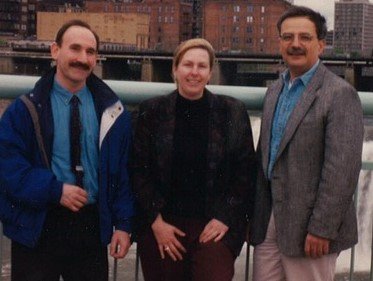World AIDS Day 2023: Remember and Commit
December 1 is World AIDS Day.
It’s been a remarkable 35 years since the first World AIDS Day in 1988.
The theme for this year is “Remember and Commit,” which started me remembering the remarkable collaboration among local, regional and global people in health care, education, business, media, LGBTQ+, faith, service, drag and other communities.
Dr. Michael Gottlieb at the Memorial Art Gallery in 2022, giving a talk on his report on the first AIDS cases. Provided by Dr. Bill Valenti
I was remembering June 5, 1981, before there was a World AIDS Day. Dr. Mike Gottlieb, who was my medical student a few years earlier, reported those cases in a publication called the Weekly Mortality and Morbidity Report, which came from Centers for Disease Control and Prevention.
That report started an era of mobilizing people through AIDS fundraisers.
Artist Ramon Santiago illustrated a flier for an AIDS fundraiser. Provided by Dr. Bill Valenti.
That mobilization continues. To mark World AIDS Day in 2016, Third Presbyterian Church hosted an event that included Thomas Warfield providing piano accompaniment to soloist Scotty Ginnett.
Sue Cowell, center, with John Altieri and Bill Valenti. Provided by Dr. Bill Valenti
In 1983, AIDS Rochester was formed by my colleague Sue Cowell, who gathered a group of people on her front porch to form this organization.
In 1985, we finally had a test for HIV. In 1987, six years into the epidemic, we have AZT, the first drug to treat HIV.
In 1989, Community Health Network opened. It was one of the first community-based HIV clinics because up to then most HIV and AIDS care was done in hospital programs.
At the opening, Congresswoman Louise Slaughter called CHN “a refuge for patients, their families and for the community.” She talked about all the good things that would happen here, including “maybe someday, a cure.”
Drs. Bill Valenti and Steve Scheibel. Provided by Dr. Bill Valenti
Steve Scheibel, as I’ve said before, was the scientific brain behind the local and global AIDS efforts. Many of his theories about HIV care were right on target and he was way ahead of his time.
In 1989, around the opening of CHN, now Trillium Health, I met a surrealist painter named Bill Copley. His wife was a physician at St. Mary’s, in our Infectious Diseases Unit. Bill was a big supporter of the AIDS movement. He painted a picture, which he called Break Thru, and presented it to me as a gift.
“Break Thru,” by Bill Copley, anticipated advances in HIV/AIDS detection and treatment. Provided by Dr. Bill Valenti
When he gave me the painting in 1990, he said, “This painting is meant to express the spirit of hope and faith that the date of the AIDS breakthrough is surely coming.”
The breakthroughs did start coming. We have the AIDS cocktail, combinations of drugs that suppress HIV. We had the idea of starting people on treatment as soon as knew they were HIV positive and not delaying treatment. The idea of treatment as prevention, where if you have what we call undetectable viral load on treatment, you don't transmit HIV to other people sexually. That’s a huge breakthrough.
We have prevention options -- once a day pills or injections every other month
We now have programs for people with HIV who are age 50 older because those people who have lived longer as a result of those early breakthroughs are now in their 50s, 60s and 70s, and they need a different level of service to meet their health care needs.
And now we’re talking about ending the HIV epidemic, which I think in itself is a pretty remarkable public health and medical achievement. So we are making progress.
Finally, the commitment piece that they're talking about for World AIDS Day this year is exactly that: They are committing to a world without AIDS.





